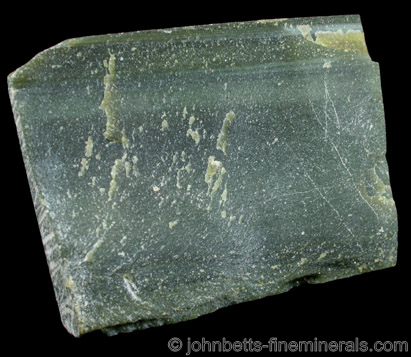The Mineral jadeite

Jadeite is most famous for its gem form of Jade. Jewelry and ornamental carvings were made from Jade throughout history. Jade was very precious in some ancient societies, and was sometimes worth even more than Gold.
Jadeite is not the only form of Jade; the amphibole mineral Nephrite (a variety of Actinolite) also has a gem form of Jade.
On a gemological standpoint, all tough masses of Jadeite and Nephrite are called Jade. The Jadeite and Nephrite forms of Jade are almost identical, and it may be very difficult to distinguish the two. In fact, they were thought to be one mineral type until 1863, when it was discovered that they are scientifically different minerals.
Jadeite Jade is the rarer and more valuable form of Jade. The most common color for both forms of Jade is pale green. Emerald-green Jade, known as Imperial Jade, is the most valuable form of Jade.
Jadeite is rarely represented in mineral collections, since it is usually uninteresting in its rough form and commercially mined only for gemstone use.
Chemical Formula
NaAlSi2O6
Color
Light to dark green, apple-green, emerald-green, gray, white, and cream-yellow. Often mottled white and light green. Occasionally also yellow, pink, purple, brown, and black; sometimes multicolored or banded.
Crystal System
Monoclinic
Properties
Streak
White |
Hardness
6.5 - 7 |
Transparency
Translucent to opaque |
Specific Gravity
3.3 - 3.5 |
Luster
Waxy, greasy; pearly on cleavage surfaces. Polished material may be vitreous. |
Cleavage
1,2 - prismatic at cleavage angles of 87º and 93º (Characteristic of minerals in the pyroxene group). Due to its lack of crystals, cleavage is rarely observed. |
Fracture
Splintery, uneven |
Tenacity
Brittle |
Crystal Habits
Visible crystals are very rare. Most often as tough masses of dense fibers and interlocking blades. These masses may be smooth and waterworn, or they may be rough and massive. When crystals do occur, they are small, slender, and in bladed aggregates.
Varieties
-
Gem form of Jadeite faceted or carved for ornamental or gemstone use.
For more information, see the gemstone Jade.
Uses
Jadeite is an important mineral, as it is the primary form of the gemstone Jade. It is cut into cabochons, beads, and earrings, and some rings and bracelets may be carved out of an entire mass of Jade. Valuable ornamental sculptures and figures are often carved from this gem.
See the gemstone section on Jade for more information.
Noteworthy Localities
Some of the finest Jadeite comes from Tawmaw, Myanmar (Burma), which is one of the largest producers of gem-quality Jade. Other important deposits are Itmurundy Massif, Krasnyi Oktyabr, Kazakhstan; Kharp, Siberia, Russia; Yunian, Tibet, China; Itoigawa, Niigata Prefecture, Japan; and Sierra de las Minas, Motagua Valley, Guatemala.
In the U.S., large masses come from Clear Creek in the Diablo Range, San Benito Co., California; and waterworn nuggets from Cape San Martin (Jade Cove), Big Sur, Monterey Co., California. Small yet visible crystals come from the Russian River in the vicinity of Cloverdale, Mendocino Co., (and nearby Sonoma Co.) California.
Distingushing Similar Minerals
Nephrite - Has a lower specific gravity than Jadeite, otherwise very difficult to distinguish.
Serpentine - Softer, less dense, has a greasy feel.